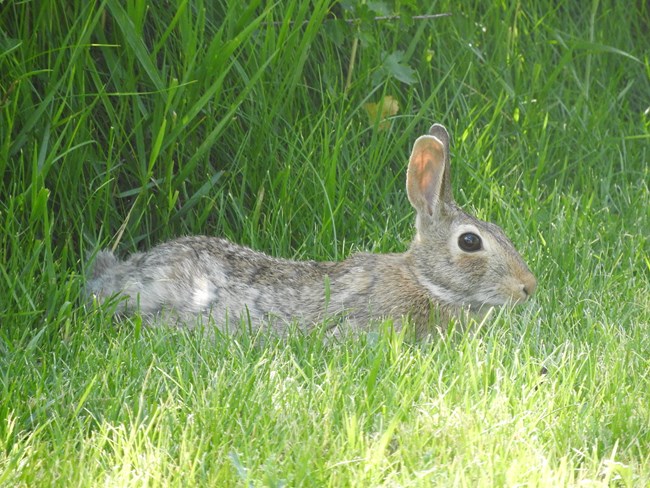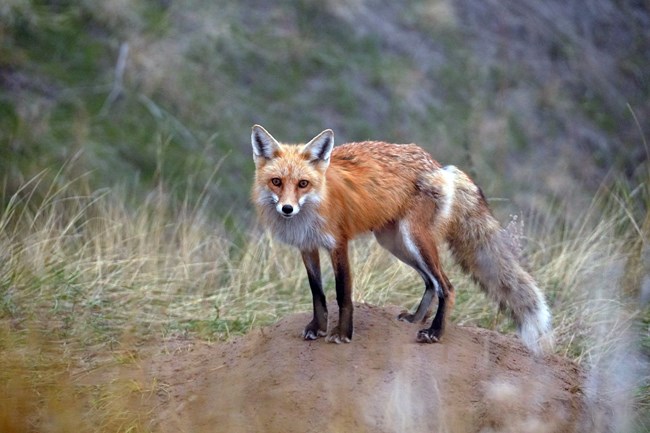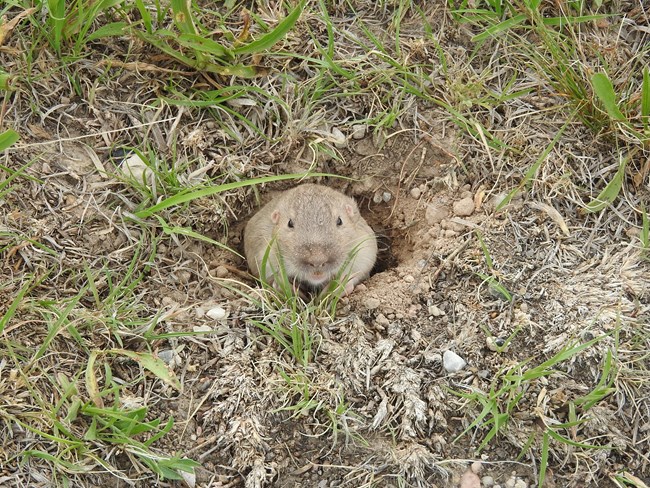Last updated: April 27, 2025
Article
Mammals of Scotts Bluff National Monument
There are 35 different species of mammals that can be seen at Scotts Bluff National Monument. Some of these mammals, like eastern cottontails and prairie dogs, are permanent residents. Others are seen in the monument only occasionally, like bighorn sheep and pronghorn.

NPS/Eric Grunwald
Eastern Cottontail
The Eastern Cottontail (Sylvilagus floridanus) is the most common rabbit in North America. It has a chunky body with red-brown or gray-brown fur. They have large hind feet, long ears, large brown eyes, and a short fluffy white tail. The cottontail's diet includes grasses, fruits and vegetables in the summer and twigs and bark in the winter. The cottontail is a very territorial animal. They do not dig burrows, but may use the abandoned burrow of another animal or create a shallow nest made of grass and lined with fur. Predators include hawks, eagles, owls, foxes, coyotes, bobcats and weasels.Deer Mice
Deer mice (Peromyscus maniculatus) have large beady eyes, large ears, and are often two-toned in color. They are accomplished jumpers and runners. The deer mouse is only three to four inches in length, not counting their tail. They vary in color from white to black, but all have white underside and feet. They are nocturnal and spend the day in trees or burrows. They feed on seeds, fruit, arthropods, leaves, and fungi.
NPS/Eric Grunwald
Red Fox
The red fox (Vulpes vulpes) is the largest of the true foxes. Red foxes adapt well to human environments such as farms, suburban areas, and even large communities. At birth the red fox is actually brown or gray. A new red coat usually grows in by the end of the first month. They feed on rodents, rabbits, and birds, but will also eat fruit fish, frogs and even worms. The fox's thick tail aids in balance, serves as a warm cover in cold weather, and as a signal flag to other foxes. They are hunted by people, along with bobcats and coyotes.Prairie Vole
The prairie vole (Microtus ochrogaster) has long, coarse grayish-brown fur on the upper portion of the body and yellowish fur on the lower portion. They have short ears and a short tail. Prairie voles are active year-round, and make shallow underground burrowsand runways through surface vegetation. In winter, they tunnel underneath the snow. Prairie voles rarely live longer than two years. They feed on grasses, roots, seeds, bark and some insects. Predators include coyotes, hawks, foxes, and snakes.
NPS/Eric Grunwald
Fox Squirrel
The fox squirrel (Sciurus niger) is the largest species of tree squirrel native to North America. The squirrel's total body length measures 18 to 28 inches and it weighs one to two pounds as a full-grown adult. In most areas, they are brownish-gray to brownish-yellow. They have sharp claws to help with climbing. Fox squirrels have excellent vision and well-developed senses of hearing and smelling. They depend primarily on tree seeds for food, but also consume buds, fruits and nuts. Predators include humans, hawks, owls, snakes and bobcats.Raccoon
The raccoon (Procyon lotor) is 16 to 28 inches long and weighs 8 to 20 pounds. The raccoon is usually nocturnal with a diet of insects, worms, fruits, and nuts. Its grayish coat of dense underfur insulates it against cold weather. Two of its most distinctive features are its extremely dexterous front paws and its facial mask. The most important sense for the raccoon is its sense of touch. Predators include bobcats, coyotes and the great horned owl.Porcupine
Porcupines (Erethizon dorsatum) are rodents with a coat sharp spines, or quills, that defend them from predators. They are the third largest rodent and are 25 to 36 inches long and weigh 12 to 35 pounds. They come in various shades of brown, gray, and rarely white. Porcupines eat leaves, twigs, and green plants and in the winter they may eat bark. They are mostly nocturnal, but will forage for food during the day. Predators of the porcupine include eagles and great forned owls.
NPS/Eric Grunwald
